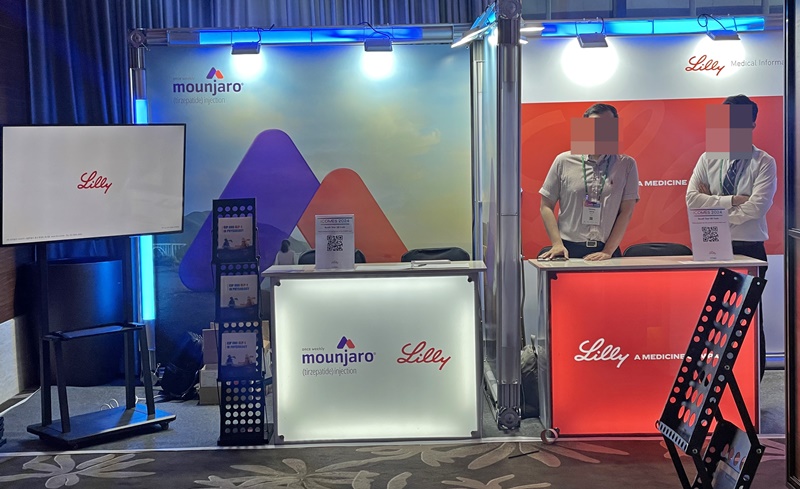- The launch of Mounjaro is imminent
- by Moon, sung-ho | translator Hong, Ji Yeon | Aug 11, 2025 06:03am
With the domestic launch of Mounjaro scheduled for mid-August, competition in the obesity treatment market, besides diabetes, is entering a new phase.
There is significant interest in the sales and marketing strategies that Eli Lilly Korea will employ to challenge Novo Nordisk's Wegovy, which was launched in the domestic market approximately a year earlier.

Mounjaro is the first and only GIP (Glucose-dependent Insulinotropic Polypeptide)/GLP-1 (Glucagon-like Peptide-1) receptor dual agonist. It is a single-molecule injectable designed to selectively bind to and activate GIP and GLP-1 receptors, allowing for once-weekly administration. It helps lower blood sugar by promoting insulin secretion, improving insulin sensitivity, and reducing glucagon concentration. Additionally, it aids in weight loss by delaying gastric emptying, which in turn reduces food intake.
In Korea, Mounjaro is approved as an adjunct drug to diet and exercise for improving glycemic control in adult patients with Type 2 diabetes (as monotherapy or combination therapy). It is also approved as an adjunct to a low-calorie diet and increased physical activity for chronic weight management in obese adults (initial BMI≥30kg/m2) or overweight adults (initial BMI≥30kg/m2) with at least one weight-related comorbidity (hypertension, dyslipidemia, type 2 diabetes, obstructive sleep apnea, or cardiovascular disease).
For both indications, the recommended starting dose is 2.5mg once a week (intended for treatment initiation and not for glycemic control or weight management). After four weeks, the dose is increased to 5mg once a week. If further dose adjustment is needed, the dose is increased by 2.5 mg after at least four weeks at the current dose, with a maximum dose of 15 mg once a week.
Meanwhile, Eli Lilly Korea has decided to initially launch the 'pre-filled pen' formulation, which was first approved in 2023, amid delays in the approval of the vial and QuickPen formulations. This is interpreted as a strategy first to release the pre-filled pen formulation and subsequently launch the other formulations once their ongoing approval process is complete.
Following the launch of Mounjaro, Eli Lilly Korea plans to implement a comprehensive sales and marketing strategy, which will include hosting symposium for medical professionals at major hospitals and clinics starting in late August.
Consequently, the clinical community's attention is focused on Mounjaro's pricing. Since obesity treatment is not reimbursed, Mounjaro's supply price will be a critical factor.
According to the pharmaceutical industry, Mounjaro is expected to be supplied at around KRW 278,000 for the 2.5mg dose (4PEN) and approximately KRW 369,000 for the 5mg dose (4PEN).
This pricing is interpreted as a strategic move, considering that Novo Nordisk Pharma's Wegovy (semaglutide) was priced at KRW 372,025 per month for all dosages when it was launched in Korea last year.
It's believed the 5mg dose was strategically priced to compete with Wegovy. Consequently, it's expected that doctors will also consider the drug's supply price when setting the average monthly price for non-reimbursed treatments.
For reference, patients typically pay an average of KRW 500,000 to 600,000 per month for Wegovy as a non-reimbursed treatment at clinics. Given this, the non-reimbursed price for Mounjaro 2.5mg is likely to be lower than that of Wegovy, while the 5mg dose may be similar to Wegovy's monthly cost.
Cheol Jin Lee, Chairman of the Korean Society for the Study of Obesity (Good Family Clinic), stated, "The vial and QuickPen formulations need approval, but it seems that the Ministry of Food and Drug Safety's (MFDS) approval is delayed." Lee added, "If the vial formulation is also launched in Korea, it would offer a significant pricing advantage. As far as we know, Mounjaro will initially be released in a pre-filled pen format, which is a disposable injectable form."
Lee noted, "Since the efficacy of this drug was confirmed in clinical trials, if it is launched, it will likely be used primarily for new patients." He explained, "This is because it would be difficult for patients who are already on high-dose Wegovy to switch to Mounjaro, which starts at a 2.5mg dose. When considering efficacy and other factors, we would likely consider Mounjaro for new patients if it is launched."
With Mounjaro's launch, the focus shifts to its competition with Wegovy in clinical practice.
Novo Nordisk is also actively ramping up its sales and marketing efforts as the first anniversary of Wegovy's domestic launch approaches. In addition to its in-house sales team of around 80 people, the company is reportedly considering a joint sales and marketing strategy with a domestic pharmaceutical company.
Chong Kun Dang is a strong candidate being discussed within the pharmaceutical industry as a domestic sales partner. However, Novo Nordisk's position is that while they are pursuing collaboration with a domestic pharmaceutical company, nothing has been finalized.
At the same time, Novo Nordisk is also seeking to expand Wegovy's indication to adolescents aged 12 and older. If this becomes a reality, it would give Wegovy a differentiated competitive edge over Mounjaro in domestic clinical practice, primarily because adolescent obesity has emerged as a significant social issue.
Eli Lilly Korea has also established its own sales force, and like Novo Nordisk, is open to collaboration with domestic pharmaceutical companies.
Although several companies, including Hanmi Pharm, are being mentioned, Lilly is expected to focus on Mounjaro's launch for the time being.
In this context, the pharmaceutical industry is also closely monitoring Eli Lilly Korea's efforts to secure reimbursement for Mounjaro's diabetes indication. There is great interest in whether it will be recognized as an innovative new drug, alongside its competitor, Ozempic.
This contrasts with Novo Nordisk's strategy, which involves applying different indications for a single product as part of its reimbursement strategy.
An official said, "We have applied to the Health Insurance Review & Assessment Service (HIRA) for national health insurance coverage and are currently awaiting consideration from the DREC." They added, "As the first GIP/GLP-1 receptor dual agonist and a new treatment for type 2 diabetes, we expect Mounjaro to provide differentiated clinical value. Therefore, we are doing our best for it to be the first chronic disease drug to receive flexible application of the ICER value for innovative new drugs."
A pharmaceutical industry official, who requested anonymity, expressed doubt about whether Mounjaro could meet the government's definition of innovation. They said, "Of course, this doesn't mean Mounjaro has no innovative value. However, we need to verify whether it meets the criteria and definition of innovativeness that the government has established. Ultimately, the question of whether it can be applied will inevitably follow."
An official also said, "We are curious about how the drug price will be set if one treatment is covered for diabetes but not for obesity," and added, "With Ozempic also pursuing reimbursement with a target of the first half of next year, this issue will become a new topic of discussion."
-

- 0
댓글 운영방식은
댓글은 실명게재와 익명게재 방식이 있으며, 실명은 이름과 아이디가 노출됩니다. 익명은 필명으로 등록 가능하며, 대댓글은 익명으로 등록 가능합니다.
댓글 노출방식은
댓글 명예자문위원(팜-코니언-필기모양 아이콘)으로 위촉된 데일리팜 회원의 댓글은 ‘게시판형 보기’와 ’펼쳐보기형’ 리스트에서 항상 최상단에 노출됩니다. 새로운 댓글을 올리는 일반회원은 ‘게시판형’과 ‘펼쳐보기형’ 모두 팜코니언 회원이 쓴 댓글의 하단에 실시간 노출됩니다.
댓글의 삭제 기준은
다음의 경우 사전 통보없이 삭제하고 아이디 이용정지 또는 영구 가입제한이 될 수도 있습니다.
-
저작권·인격권 등 타인의 권리를 침해하는 경우
상용 프로그램의 등록과 게재, 배포를 안내하는 게시물
타인 또는 제3자의 저작권 및 기타 권리를 침해한 내용을 담은 게시물
-
근거 없는 비방·명예를 훼손하는 게시물
특정 이용자 및 개인에 대한 인신 공격적인 내용의 글 및 직접적인 욕설이 사용된 경우
특정 지역 및 종교간의 감정대립을 조장하는 내용
사실 확인이 안된 소문을 유포 시키는 경우
욕설과 비어, 속어를 담은 내용
정당법 및 공직선거법, 관계 법령에 저촉되는 경우(선관위 요청 시 즉시 삭제)
특정 지역이나 단체를 비하하는 경우
특정인의 명예를 훼손하여 해당인이 삭제를 요청하는 경우
특정인의 개인정보(주민등록번호, 전화, 상세주소 등)를 무단으로 게시하는 경우
타인의 ID 혹은 닉네임을 도용하는 경우
-
게시판 특성상 제한되는 내용
서비스 주제와 맞지 않는 내용의 글을 게재한 경우
동일 내용의 연속 게재 및 여러 기사에 중복 게재한 경우
부분적으로 변경하여 반복 게재하는 경우도 포함
제목과 관련 없는 내용의 게시물, 제목과 본문이 무관한 경우
돈벌기 및 직·간접 상업적 목적의 내용이 포함된 게시물
게시물 읽기 유도 등을 위해 내용과 무관한 제목을 사용한 경우
-
수사기관 등의 공식적인 요청이 있는 경우
-
기타사항
각 서비스의 필요성에 따라 미리 공지한 경우
기타 법률에 저촉되는 정보 게재를 목적으로 할 경우
기타 원만한 운영을 위해 운영자가 필요하다고 판단되는 내용
-
사실 관계 확인 후 삭제
저작권자로부터 허락받지 않은 내용을 무단 게재, 복제, 배포하는 경우
타인의 초상권을 침해하거나 개인정보를 유출하는 경우
당사에 제공한 이용자의 정보가 허위인 경우 (타인의 ID, 비밀번호 도용 등)
※이상의 내용중 일부 사항에 적용될 경우 이용약관 및 관련 법률에 의해 제재를 받으실 수도 있으며, 민·형사상 처벌을 받을 수도 있습니다.
※위에 명시되지 않은 내용이더라도 불법적인 내용으로 판단되거나 데일리팜 서비스에 바람직하지 않다고 판단되는 경우는 선 조치 이후 본 관리 기준을 수정 공시하겠습니다.
※기타 문의 사항은 데일리팜 운영자에게 연락주십시오. 메일 주소는 dailypharm@dailypharm.com입니다.
- [Op-Ed] Patients, no time left for 'new drug comb therapies'
- Special Contribution | Eo, Yun-Ho









